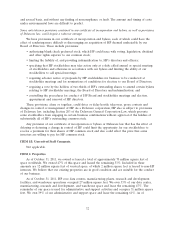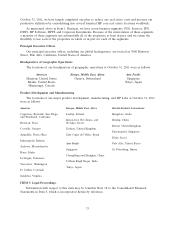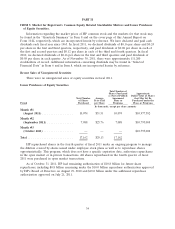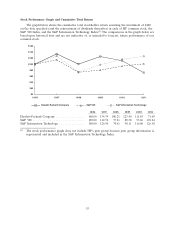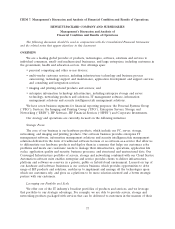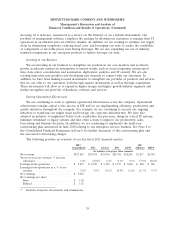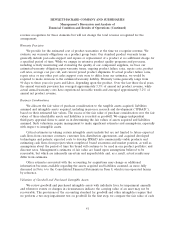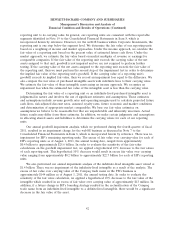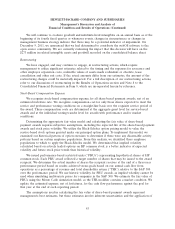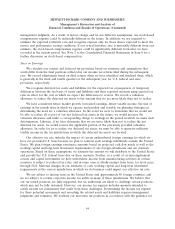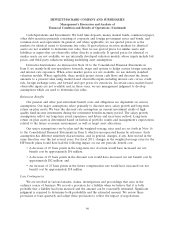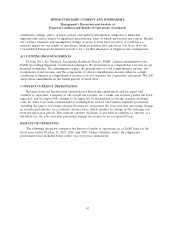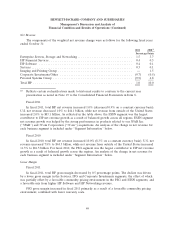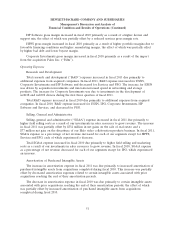HP 2011 Annual Report Download - page 50
Download and view the complete annual report
Please find page 50 of the 2011 HP annual report below. You can navigate through the pages in the report by either clicking on the pages listed below, or by using the keyword search tool below to find specific information within the annual report.HEWLETT-PACKARD COMPANY AND SUBSIDIARIES
Management’s Discussion and Analysis of
Financial Condition and Results of Operations (Continued)
reporting unit to its carrying value. In general, our reporting units are consistent with the reportable
segments identified in Note 19 to the Consolidated Financial Statements in Item 8, which is
incorporated herein by reference. However, for the webOS business within Corporate Investments, the
reporting unit is one step below the segment level. We determine the fair value of our reporting units
based on a weighting of income and market approaches. Under the income approach, we calculate the
fair value of a reporting unit based on the present value of estimated future cash flows. Under the
market approach, we estimate the fair value based on market multiples of revenue or earnings for
comparable companies. If the fair value of the reporting unit exceeds the carrying value of the net
assets assigned to that unit, goodwill is not impaired and we are not required to perform further
testing. If the carrying value of the net assets assigned to the reporting unit exceeds the fair value of
the reporting unit, then we must perform the second step of the impairment test in order to determine
the implied fair value of the reporting unit’s goodwill. If the carrying value of a reporting unit’s
goodwill exceeds its implied fair value, then we record an impairment loss equal to the difference. We
also compare the fair value of purchased intangible assets with indefinite lives to their carrying value.
We estimate the fair value of these intangible assets using an income approach. We recognize an
impairment loss when the estimated fair value of the intangible asset is less than the carrying value.
Determining the fair value of a reporting unit or an indefinite-lived purchased intangible asset is
judgmental in nature and involves the use of significant estimates and assumptions. These estimates
and assumptions include revenue growth rates and operating margins used to calculate projected future
cash flows, risk-adjusted discount rates, assumed royalty rates, future economic and market conditions
and determination of appropriate market comparables. We base our fair value estimates on
assumptions we believe to be reasonable but that are unpredictable and inherently uncertain. Actual
future results may differ from those estimates. In addition, we make certain judgments and assumptions
in allocating shared assets and liabilities to determine the carrying values for each of our reporting
units.
Our annual goodwill impairment analysis, which we performed during the fourth quarter of fiscal
2011, resulted in an impairment charge for the webOS business as discussed in Note 7 to the
Consolidated Financial Statements in Item 8, which is incorporated herein by reference. There was no
impairment for HP’s remaining reporting units. The excess of fair value over carrying value for each of
HP’s reporting units as of August 1, 2011, the annual testing date, ranged from approximately
$0.4 billion to approximately $25.6 billion. In order to evaluate the sensitivity of the fair value
calculations on the goodwill impairment test, we applied a hypothetical 10% decrease to the fair values
of each reporting unit. This hypothetical 10% decrease would result in excess fair value over carrying
value ranging from approximately $0.2 billion to approximately $22.7 billion for each of HP’s reporting
units.
We also performed our annual impairment analysis of the indefinite-lived intangible asset valued at
$1.4 billion. There was no impairment of the indefinite-lived intangible as a result of the analysis. The
excess of fair value over carrying value of the Compaq trade name in the PSG business is
approximately $144 million as of August 1, 2011, the annual testing date. In order to evaluate the
sensitivity of the fair value calculation, we applied a hypothetical 10% decrease to the fair value of the
intangible which resulted in an excess of fair value over carrying value of approximately $13 million. In
addition, if a future change in HP’s branding strategy resulted in the reclassification of the Compaq
trade name from an indefinite-lived intangible to a definite-lived intangible, there would be a significant
decrease in the fair value of the asset.
42


